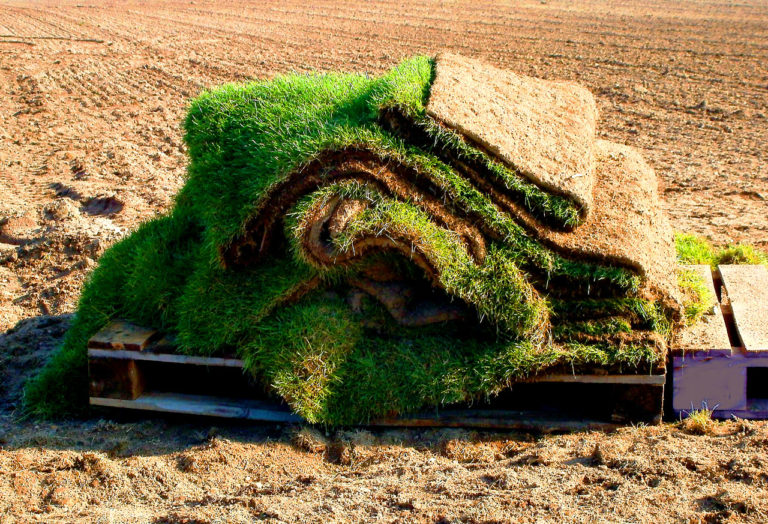Are you laying new sod and thinking about simply laying the boundary wire for your robotic mower directly under the sod? You are not alone; many people come up with this idea. At least you save yourself the trouble of digging the cable in. But is this a good idea?
Should the boundary wire be laid directly underneath when laying sod? In most cases, it is not a good idea to lay the cable directly under the sod. It is often necessary to make cable improvements that cannot be easily fixed when the cable is under sod. A better idea is to lay the cable above ground before laying it underground.
It is also a legitimate question whether the boundary wire should be laid underground at all. How you should proceed and how to come to a decision, I will tell you here.
Contents
When Laying the Sod, Should You Lay the Boundary Wire Directly Under It?
Basic Question: Underground Installation or Not?
First of all, you should answer the question whether it makes sense in principle to lay the cable underground at all, because it does not necessarily have to be. The boundary wire can also very well simply be laid above ground, on the turf. After some time, usually about 6 weeks, it will grow into the ground and is practically no longer visible.
Let’s consider how the whole thing works for the time being, regardless of sod.
Above-ground Installation Has Several Advantages
- For one thing, it is simply less complex. To lay the cable underground, you usually have to make a long furrow at the edge of your lawn, into which the cable has to be sunk (not with sod, of course, but more about that later). This is not necessary when laying the cable above ground. However, you have to fix the cable to the ground with hooks, which is a bit of work.
- You can also make corrections very easily when the cable is lying above ground. This may well be necessary. You may lay your boundary wire and watch your robotic mower for a while, but then notice that it often gets stuck on certain corners and edges or does not cut the grass properly.
- In the case of an above-ground cable, a quick readjustment is easily made. This becomes much more difficult if the cable is laid underground. You would first have to dig out the cable, slightly offset the furrow and then sink the cable again. Most of the time, people just prefer to leave it and be satisfied with the not quite perfect result.
But There Are Also Disadvantages
- However, a disadvantage of underground installation may be that the cable is more easily damaged. Here it depends a little on how careful you are when you are working in the yard, e.g. when aerating the lawn or handling other yard tools that could damage the cable.
In Contrast, Underground Installation Also Offers Certain Advantages
- In contrast to laying the cable above ground, you do not have the problem of the cable being easily damaged during yarding work. It depends a bit on whether you pay attention to the cable in the yard or not. It is very easy to scarify the lawn with an above-ground boundary wire without damaging it, you just have to be a bit more careful.
- Underground installation does not necessarily have to be more complex. For example, you can create the furrow quite easily with an old angle grinder. This is quite fast and can even be done faster than fixing the cable with landscaping hooks.
- With a roll of sod, you don’t even have to make a furrow if you lay the cable directly underneath it. So that makes it even easier.
However, the Disadvantages Are Obvious
- Subsequent corrections are just not that easy. Perhaps you have not chosen the right distance at one point or another? Or the robotic mower always gets hung up on this one particular corner and you always have to “save” it? Then it is really unfavorable if the cable is already under the ground.
But maybe you are just so sure that you are doing everything right when you are laying the floor, or maybe it is not so important to you that everything is perfect. Maybe your yard is very simple and there is no danger of any areas needing to be corrected and you want to make it easy for yourself and lay the boundary wire directly underground.
The Cable Should Run Underground: So when Laying Sod, Lay It Directly Underneath?
If you are absolutely sure that you do not want to correct anything on the boundary wire, you can also lay it directly under the sod. However, I would not recommend this the first time you lay a boundary wire. I would also say that in a rough estimation of 80% of cases, subsequent corrections are necessary.
However, there is also the possibility of combining the advantages of above-ground and underground installation by simply laying the cable above ground first and fixing it with the fixing hooks. Then you let your robotic mower test drive for one or two weeks.
You observe how it mows the corners and edges, whether it does everything the way you want it to, or whether it has problems in one place or another. Then you correct the cable at the appropriate place. It helps if you wrap a small piece of cable around the hooks in some places when laying the cable, so that you have some slack to use for adjustments.
If you are satisfied with the cable after a few weeks, you can place it under the sod. But until when is that actually possible?
Does It Really Make Sense to Lay the Boundary Wire Under the Sod?
Basically, it is not necessary to lay the boundary wire under the sod. Even if you simply place it on the turf, yit will become embedded at some point. It will grow into the grass and, to a certain extent, dig itself into the lawn.
A prerequisite for this is that the lawn is mowed as short as possible when the cable is laid. Even if you scarify your lawn, this is not such a big problem. You can simply leave out the edges, because scarifying is not absolutely necessary there.
Also consider that you may want to make changes to your yard at some point. Perhaps a new garden bed will be planted somewhere? Or a playground for your children? Or a pond?
Such adjustments are much easier to make with an above-ground boundary wire than with an underground cable. So I would think twice before I really decide to lay the boundary wire underground.
However, there is one exception: the connections between the outer boundary wire and created islands. If you scarify your lawn, you must remember these points and take care not to go over them so as to avoid damaging the cable.
However, it is also absolutely possible to choose a combination of above-ground and underground installation. You can lay connecting lines between the outer boundary wire and islands underground, while you lay the rest above ground, for example.
If your robotic mower also has a guide wire, I would actually lay it underground. Here, corrections have to be made much less often, because it does not depend on centimeter-precise work – apart from bottlenecks through which the robotic mower has to pass.
Related Questions
How long can you lay the wire underneath after you have laid the sod? With proper watering and maintenance, sod needs about 6 weeks to take root completely. However, you should not wait that long. If the boundary wire is to be laid under the sod, this should be done in the third week at the latest, otherwise the sod will already be too deeply rooted.
What help is available when laying the boundary wire? When laying the boundary wire, a so-called laying aid roll can help you. This helps you to lay the boundary wire both above and below ground. There are also many creative ideas for creating a furrow, which can be used to do this. An old angle grinder, for example, can be very helpful.
Also interesting: 10 useful tools for laying the boundary wire
08/20/2020
Recent Content
Are you looking to buy a robotic lawn mower? I think there has never been a better time, since the most recent models on the market are actually quite sophisticated so that it can now be appealing...
High-end robotic lawnmowers can be a significant investment, so I was curious about how often they get stolen and did some research on the topic. Although there is no specific data available on...

